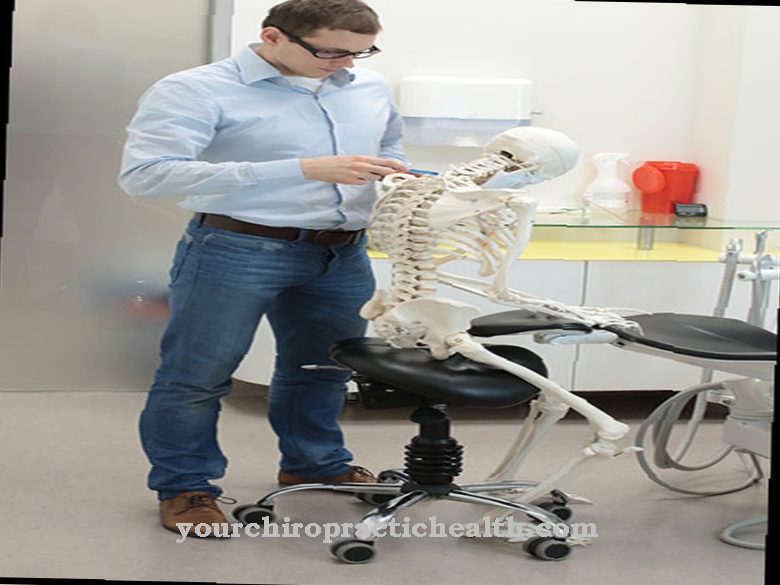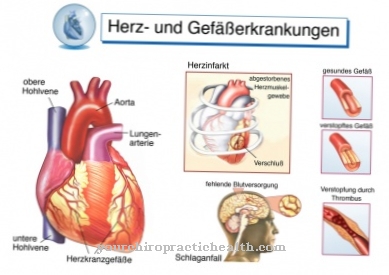The Early dyskinesia is a medical term used to describe a fairly common side effect of drugs that interfere with dopamine metabolism. Since such drugs are mainly used for the therapy of psychoses, schizophrenia and states of agitation, early dyskinesia is a common side effect, especially in psychiatry and neurology. However, anti-emetic drugs such as MCP or domperidone can also trigger early dyskinesia.
What is early dyskinesia?

© Spectral-Design - stock.adobe.com
Early dyskinesia is a movement disorder that can occur during treatment with antidopaminergic drugs such as neuroleptics or antiemetics.
Acute or after a few days of regular use, involuntary movements such as twitching of the corner of the mouth, throat cramps or sitting restlessness occur. The side effect can be treated well with anticholinergic infusions.
causes
Dopamine is an important messenger substance in the central nervous system and necessary for planning and coordinating movements. In the pathogenesis of Parkinson's disease, for example, dopamine plays a decisive role, resulting in a lack of exercise and rigidity and a common symptom in people with Parkinson's disease.
In the case of early dyskinesia, in principle the opposite is the case, too much exercise, because this can no longer be adequately inhibited or slowed down by the influence of dopamine.
Drugs that cause this block dopamine receptors in the brain. This is sometimes a side effect, but sometimes at the same time its desired effect, since dopamine inhibition can slow down the induction of vomiting, for example. Metoclopramide (MCP) and domperidone are antidopaminergic substances that are used as anti-emetic drugs against vomiting. Since this often only happens for a short time, early dyskinesias are rare with antiemetic therapy.
They occur more frequently as a reaction to the antidopaminergic partial effect of neuroleptics: These substances inhibit the development of delusions and hallucinations by interfering with the metabolism of dopamine but also other neurotransmitters such as acetylcholine, serotonin or histamine and are therefore used in a variety of psychiatric diseases, They are also very popular for calming and sedation, for example in intensive care units.
The stronger the antipsychotic effect, the stronger the undesirable effect on the motor system: early dyskinesia, late dyskinesia and other so-called extrapyramidal motor side effects are the result of long-term use. Older neuroleptics such as chlorpromazine and levomepromazine, haloperidol or melperon are particularly affected.
Newer, so-called atypical neuroleptics such as clozapine, olanzapine or risperidone have been specifically developed, among other things, so that they have fewer such side effects.
You can find your medication here
➔ Medicines to calm down and strengthen nervesSymptoms, ailments & signs
Early dyskinesia is associated with various ailments and symptoms. In any case, these have a very negative effect on the quality of life of the person concerned and can lead to serious complications. In most cases, early dyskinesia consists primarily of involuntary movements and, as a rule, chewing movements with the mouth.
The early dyskinesia can also lead to inner restlessness and psychological complaints. The patients often cannot concentrate properly and also suffer from impaired coordination. If the early dyskinesia is not treated and the triggering drug continues to be grounded, it can lead to cramps in the muscles or difficulty breathing.
In the worst case, early dyskinesia can also cause inflammation in the brain and reduce the life expectancy of the person affected. However, in some cases, the inflammation occurs elsewhere on the body. The severity of the symptoms differs in different people and depends on the medication taken.
In most cases, the disease can be treated well if the drug is stopped. Long-term damage usually only occurs if the early dyskinesia is not treated early.
Diagnosis & course
The symptoms of early dyskinesia arise through "inhibition of inhibition" (disinhibition, so to speak) in the motor centers of the central nervous system: After a few days of long-term use of the drug, eye cramps occur, tonic head tilt caused by muscle cramps or pharyngeal cramps up to shortness of breath.
Furthermore, the sitting restlessness (akathisia) is a typical side effect, nesting movements of the hands can occur. The opposite is also possible, a Parkinson's-like paralysis of muscles and movement. All of these motor symptoms are involuntary and may be distressing because they cannot be controlled.
Other possible causes of these symptoms are neurological dyskinesias, strychnine poisoning, tetanus or encephalitis. Nevertheless, the history of taking the medication usually gives a clear indication of the cause and suggests the diagnosis of early dyskinesia. The effectiveness of the prompt therapy under these circumstances is then the definitive proof of the diagnosis.
Complications
The early dyskinesis leads to various complaints that can put a relatively heavy strain on the everyday life of the person affected and significantly reduce the quality of life. This leads to increased movements, which in most cases are involuntary. Different parts of the body can be affected by these movements and twitches.
The patient also suffers from involuntary movements in the area of the mouth so that he does not chew on his own. This injures the teeth, causing pain and damage in the mouth area. There is also general malaise and inner restlessness.
It is not uncommon for the muscles to cramp due to the early dyskinesis and shortness of breath can occur. In the worst case, the patient dies due to shortness of breath. Furthermore, the disease can lead to inflammation all over the body. The brain in particular can be affected by these.
The early dyskinesis can be treated well so that there are no more complications and complaints. The treatment is usually carried out with the help of medication. As a rule, life expectancy is not restricted.
When should you go to the doctor?
Movement disorders that are not based on overexertion or physical exertion should be monitored by a doctor. If the symptoms persist for several days, this is considered unusual and must be clarified by a doctor. A tilted position of the head, the shoulders or the upper body should be presented to a doctor. Without a correction of the physical changes, the affected person is at risk of permanent damage to the skeletal system.
If there are headaches, cramps, stiffness or other muscle problems all over the body, it is advisable to consult a doctor. Parasitic sensations such as twitching or numbness on the skin should be examined and treated. If the symptoms increase or their intensity increases, a doctor should be consulted immediately. If the patient has recently started taking neuroleptics, early dyskinesia may be a side effect of the drug. At the first signs it is necessary to consult the attending physician in order not to suffer any permanent health problems.
A doctor should be consulted in the event of internal restlessness or malaise. If relatives can observe unusual eye movements in the patient or if the eyes malfunction, a doctor's visit is necessary. If irregularities in the muscles are noticed when chewing or if the movements of the jaw can no longer be deliberately controlled, a doctor should examine and clarify the symptoms.
Doctors & therapists in your area
Treatment & Therapy
Early dyskinesia can usually be treated very well with an antidote: the anticholinergic Biperiden inhibits the development and transmission of motor impulses in the brain and thus prevents involuntary movements.
Given intravenously as an infusion, the agent should work after a few minutes. Otherwise the infusion can be repeated after half an hour; oral administration as tablets is then possible and necessary.
Another possibility, especially in the case of contraindications to an anticholinergic, is therapy with benzodiazepines, which are also widely used as sleeping pills or in anesthesia and generally dampen the brain somewhat for a short time.
Outlook & forecast
Since early dyskinesia is caused in most patients by the administration of drugs with an antidopaminergic effect, existing symptoms often recede after changing the treatment plan and stopping the preparations taken. Often these patients are free of symptoms.
Alternatively, the abnormal movements are treated by administering appropriate antidotes. The prognosis for early dyskinesia is generally favorable, but still depends on the underlying disease and the severity of the impairments.
If the early dyskinesia has been present for several days, it can lead to shortness of breath or other complications. This means that secondary illnesses are possible that lead to a deterioration in health. They have a negative impact on the patient's quality of life and, in the worst case, can contribute to a reduction in life expectancy.
Without adequate medical care, there can be severe impairment in coping with everyday life. Inflammations in the brain can also develop, which are associated with functional restrictions and permanent damage.
If there is adequate medical treatment, early dyskinesia can be treated well with the available options. The sooner the therapy is given, the faster the symptoms will subside. The risk of lifelong sequelae is also reduced in these cases.
You can find your medication here
➔ Medicines to calm down and strengthen nervesprevention
Prevention of early dyskinesia is difficult because it is a fundamental side effect of drugs. In principle, these should of course only be prescribed if they are absolutely necessary. Careful weighing between the effect and possible side effects is necessary with every therapy. In the case of long-term neuroleptic therapy, education about possible symptoms and their early detection are particularly important in order to be able to initiate countermeasures at an early stage.
Aftercare
In most cases, the options for follow-up care for early dyskinesia are very limited. As a rule, the patient first has to rely on direct medical treatment by a doctor in order to treat the symptoms correctly and, above all, completely. Self-healing cannot occur in early dyskinesia.
The earlier the disease is detected, the better the further course of the disease. In most cases, this disease is treated with the help of medication, and special complications usually do not occur. Care must be taken to ensure that these drugs are taken correctly and, above all, that they are used regularly in order to accelerate healing.
In some cases, however, the active ingredients are introduced into the body by infusion, which requires a stay in a hospital. In general, the care and support of friends and family has a very positive effect on the course of early dyskinesia and can alleviate psychological complaints.
Those affected are often dependent on intensive care. Contact with other people affected by this disease can also be useful. It cannot generally be predicted whether early dyskinesia will reduce the life expectancy of those affected.
You can do that yourself
Since early dyskinesia is a side effect of medication, the disease can of course be avoided by explaining the risks and effects when choosing medication. The respective medication should therefore really only be postponed and taken if the disease cannot be treated differently. The doctor should inform the patient about the possible side effects, especially if it is taken for a long time.
Self-help options are not available to the patient. Those affected will then have to take other medications to alleviate the side effects. However, a doctor should always be consulted before taking new medication and before discontinuing medication.
In severe cases, early dyskinesia can also lead to loss of consciousness or difficulty breathing. In this case, you should go to a hospital directly or call an emergency doctor to avoid further complications. Until the emergency doctor arrives, the person concerned must be given emergency ventilation and placed in a stable lateral position.
It is advisable to calm the patient down if there is any inner restlessness. However, medical treatment is still urgently required.






.jpg)

















.jpg)



